Wednesday, September 28, 2011
infinity elephants
Something a little different today. Vi Hart has a whole series of videos called 'Doodling in Math Class' which are awesome (which you can find on YouTube). While she disavows having a love for numbers, seeming to favour geometry over algebra, these are wonderfully talky videos with a real love of the beauty of mathematics (over the unloveable way it is too often taught) and drawing.
I confess, I think in a very similar way sometimes. I'm flumoxed by the question, "What are you thinking?", because I'm unconvinced anyone wants to hear this sort of monologue, though I'm charmed hearing hers.
I also love the Möbius Strip Musical Box.
Find more on her website.
Labels:
art about mathematics,
art about science,
camel,
doodles,
drawing,
elephant,
geometry,
graph theory,
infinity,
mathematics,
music,
snakes,
video
Thursday, September 15, 2011
headgear in the wild
Speaking of interesting things on heads, I love the series of illustrations of animals in hats by Lisa Hanawalt featured on the hair pin in honour of New York Fashion Week. Be sure to check out the rest. (via Etsy Tumblr)





The colour blocking morbidity bonnet is the best thing ever. I think she's satirizing fashion with love.





The colour blocking morbidity bonnet is the best thing ever. I think she's satirizing fashion with love.
Labels:
animals,
fashion illustration,
hats,
illustration,
Lisa Hanawalt
Wednesday, September 14, 2011
Collectors
Tiny Showcase brought illustrator Lauren Nassef to my attention this morning. I've been perusing her portforlio (and you should to - you won't be disappointed). The thing which seemed the most magpie-like to share was her collector series. After all, we've had animals, tea sets, and wunderkammers on heads before. This series of illustrations though, is for the specialist collectors:
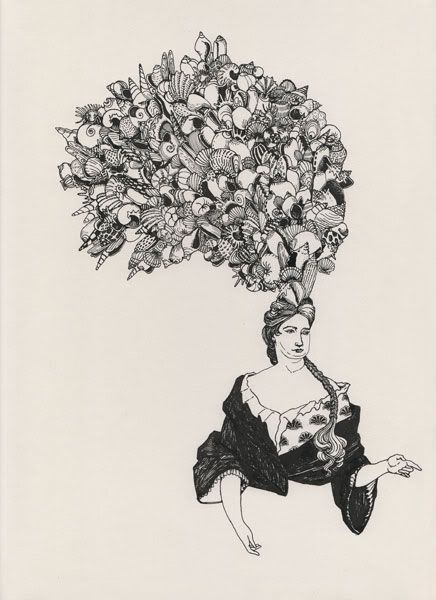
Duchess, shell collector
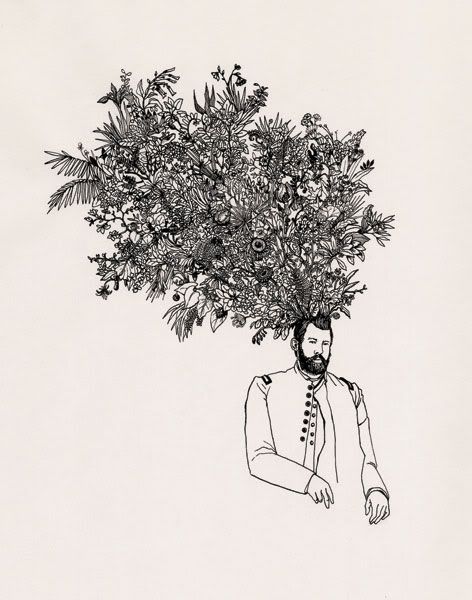
Edward Palmer, plant collector
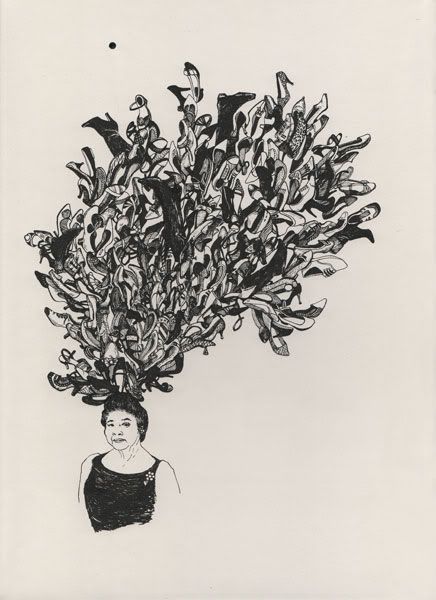
Imelda Marcos, shoe collector
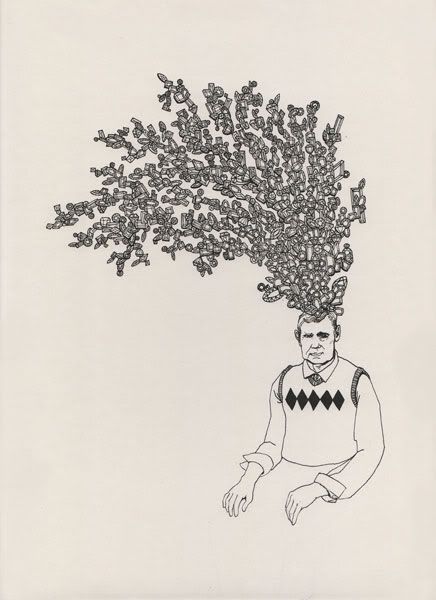
Mr. A.C.D. Pain, mineral and gemstone collector
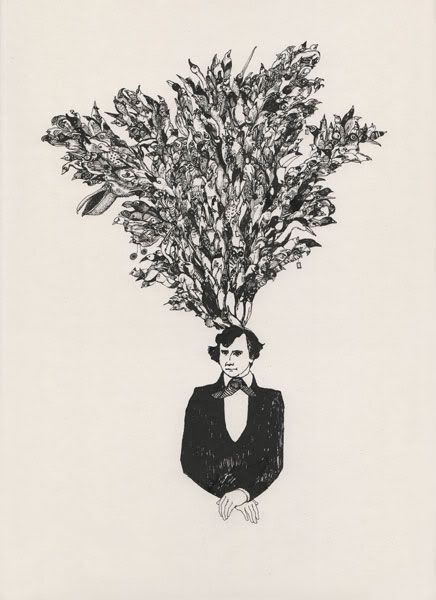
John Kirk Townsend, bird collector
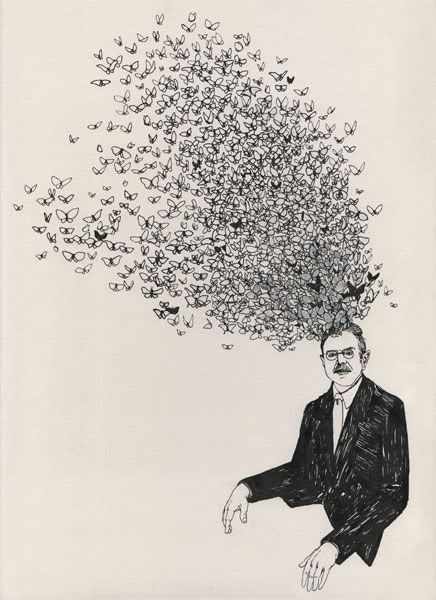
Andrey Avinoff, butterfly collector
Do look at her site. There is much, much more to see.

Duchess, shell collector

Edward Palmer, plant collector

Imelda Marcos, shoe collector

Mr. A.C.D. Pain, mineral and gemstone collector

John Kirk Townsend, bird collector

Andrey Avinoff, butterfly collector
Do look at her site. There is much, much more to see.
Monday, September 12, 2011
Automata
This tiny automaton, presented by German watchmaker, Peter Kintzing to Marie Antoinette in 1784, is central to the Châteu de Verseille's current exhibit of science and curiosities at the Court of Verseille. Hidden beneath her dress is the complex mechanism which allows for her naturalistic movements and musical playing of the dulcimer. The queen immediately presented her delightful toy to the Académie des Sciences, because she recognized this engineering triumph, a marriage of art and science of course, as something which should be commemorated.
(via TeenAngster)

 It reminded me of the karakuri ningyo, the 200 year old Japanese mechanical dolls, which I saw at the Canadian Museum of Civilization's "Japan: Tradition. Innovation." exhibit. The exhibit traced contemporary Japanese robots and society's fascination with robots back to the tradition of building these automata. The images show a plan from 'Karakuri Zuii' ('Karakuri - An Illustrated Anthology') published in 1796 and Chahakobi Ningyo (Tea Serving Doll) by SHOBEI Tamaya IX (via karakuri.info).
It reminded me of the karakuri ningyo, the 200 year old Japanese mechanical dolls, which I saw at the Canadian Museum of Civilization's "Japan: Tradition. Innovation." exhibit. The exhibit traced contemporary Japanese robots and society's fascination with robots back to the tradition of building these automata. The images show a plan from 'Karakuri Zuii' ('Karakuri - An Illustrated Anthology') published in 1796 and Chahakobi Ningyo (Tea Serving Doll) by SHOBEI Tamaya IX (via karakuri.info). Also, having recently read Thomas Pynchon's Mason & Dixon I can't help but be reminded of Vaucason's mechanical (and digesting) duck. Given a choice I would rather an automaton which did something pleasant, like play music, or useful, like bring me tea, rather than eat and poop, but it is quite amazing to consider the range of movements and achievements of these proto-robots, more than two centuries ago. So much so, that in 1770 by Wolfgang von Kempelen (1734–1804) was able to hoodwink even educated court audiences with the Mechanical Turk, a chess-playing automaton hoax. (To build a chess-playing machine (which not only could move pieces appropriately, but beat highly-skilled human opponents) did take a couple more centuries, because playing chess involves much more than movements, it requires some artificial intelligence.) Vaucanson's more obviously useful output includes the first automated loom - employing punch-cards, foreshadowing 20th century methods for inputting data to computers.
Also, having recently read Thomas Pynchon's Mason & Dixon I can't help but be reminded of Vaucason's mechanical (and digesting) duck. Given a choice I would rather an automaton which did something pleasant, like play music, or useful, like bring me tea, rather than eat and poop, but it is quite amazing to consider the range of movements and achievements of these proto-robots, more than two centuries ago. So much so, that in 1770 by Wolfgang von Kempelen (1734–1804) was able to hoodwink even educated court audiences with the Mechanical Turk, a chess-playing automaton hoax. (To build a chess-playing machine (which not only could move pieces appropriately, but beat highly-skilled human opponents) did take a couple more centuries, because playing chess involves much more than movements, it requires some artificial intelligence.) Vaucanson's more obviously useful output includes the first automated loom - employing punch-cards, foreshadowing 20th century methods for inputting data to computers.There are also tales of ancient and medieval automata. The Book of Ingenious Devices published in 850 by the three Persian brothers known as the Banu Musa (Ahmad, Muhammad and Hasan bin Musa ibn Shakir) working at the House of Wisdom (Bayt al-Hikma) in Baghdad, Iraq, under the Abbasid Caliphate, includes many machines and automata, including a mechanical flute player described as the first programmable device.
Friday, August 26, 2011
Hair
Illustrations of hair seem to be everywhere lately (actually, for a couple of years now). Perhaps it's another Victorian allusion, what with their hair ornaments, jewellery and other (possibly morbid) memorials?

Ghost of a Tether, Gala Bent, 2010
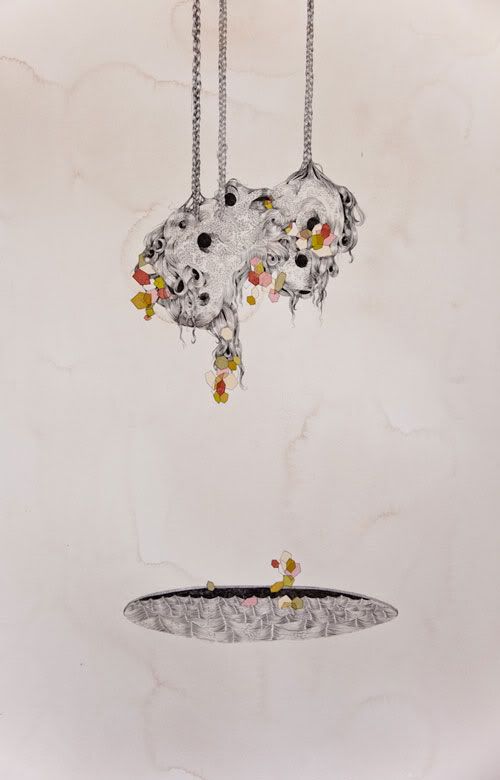
The Transmogrification Stunt, Gala Bent, 2009
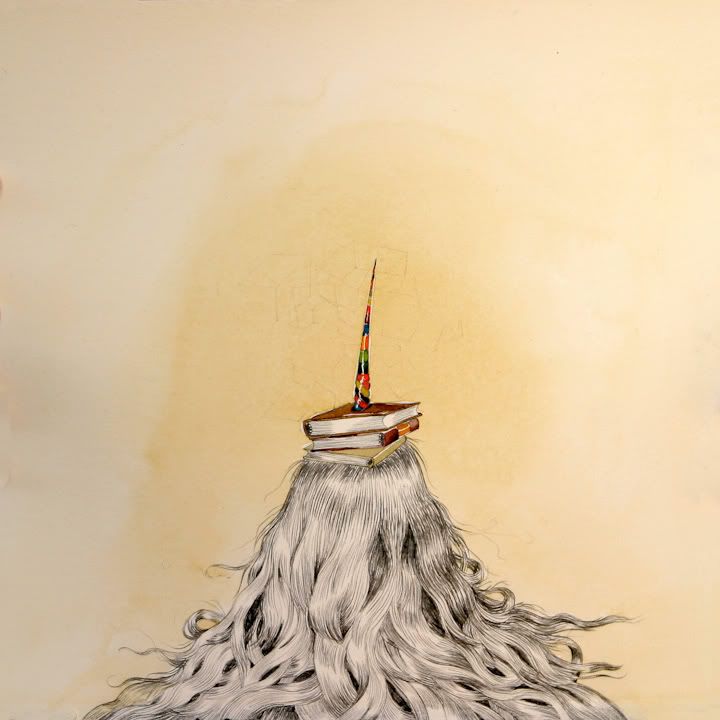
Unicorn, Gala Bent, 2009
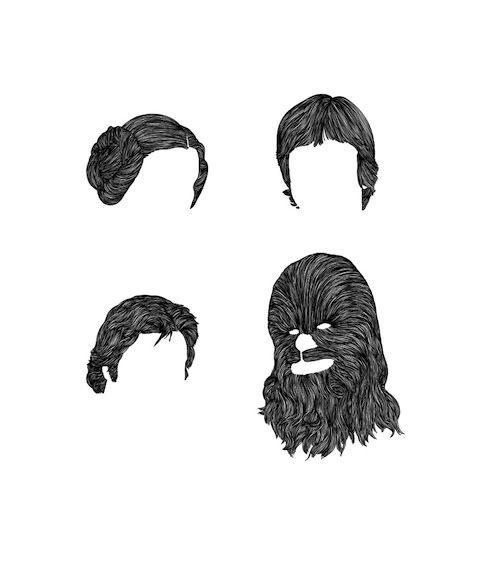
Star Wars, a hair portrait by Mr Bingo
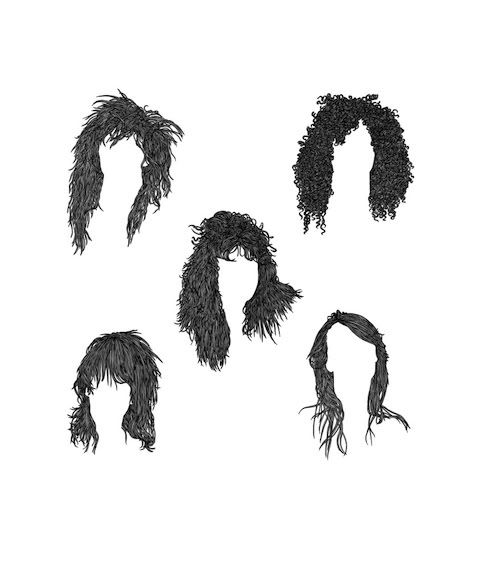
Guns n Roses Hair Portrait by Mr Bingo

The Mighty Boosh Hair Portrait by Mr Bingo
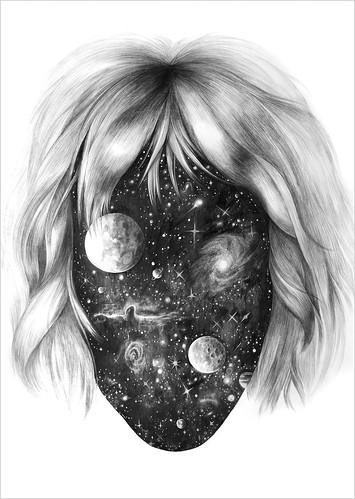
Entire inside, Title of the project: Everything is connected, pencil drawing, size A1 (840mm*600mm) by Eika Dopludo
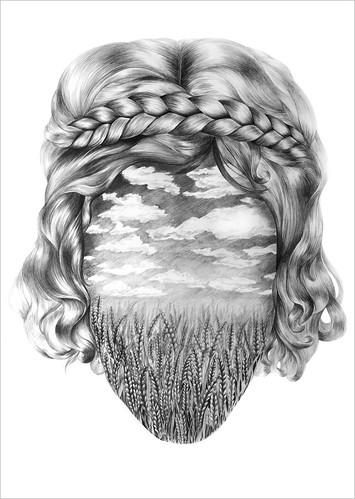
Into the nature, Title of the project:
Everything is connected, pencil drawing, size A1 (840mm*600mm) by Eika Dopludo
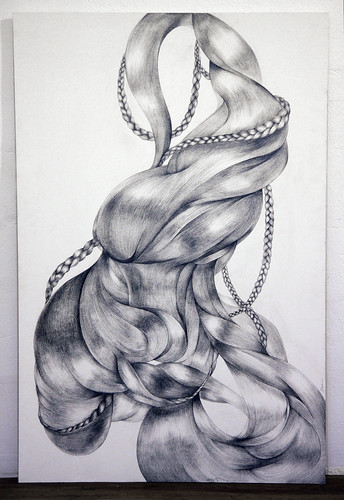
hair meditation © Eika. pencil drawing, size: 200см*150см
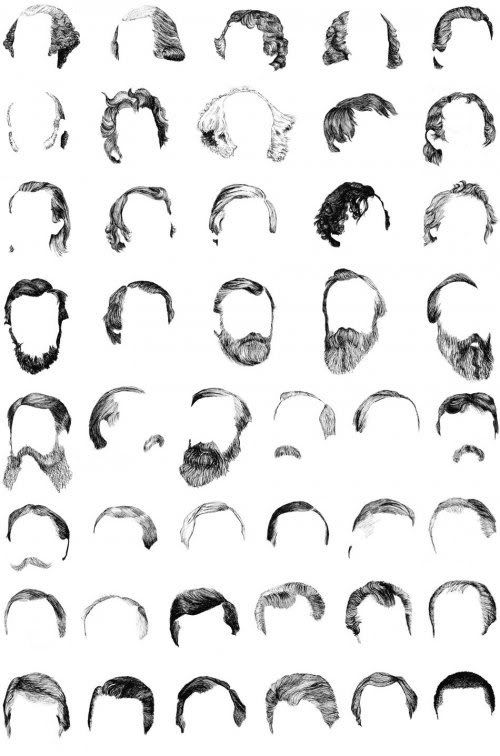
Presendential hair portraits by Christina Christoforou (who published a whole book called 'Whose Hair?')
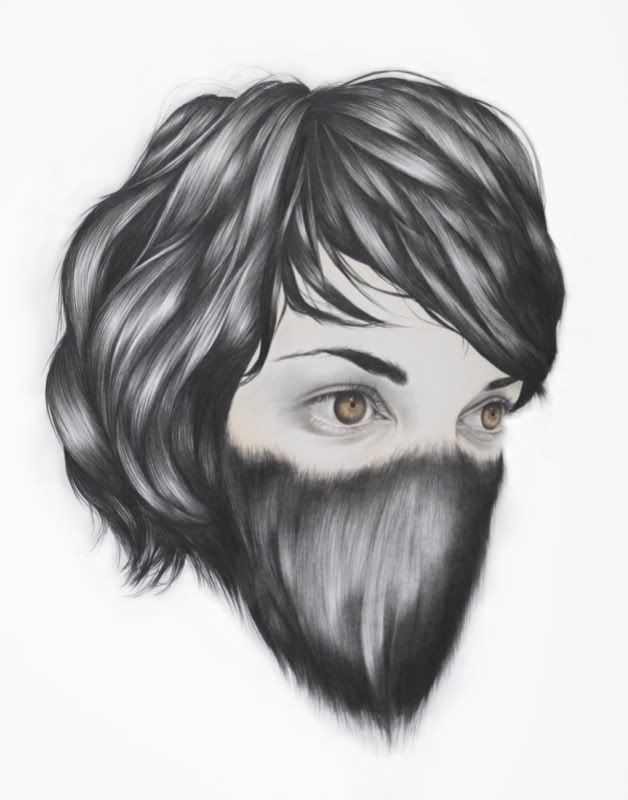
Sister by Langdon Graves
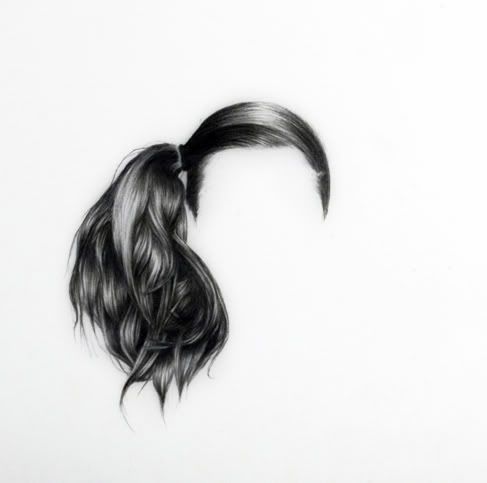
Side by Langdon Graves
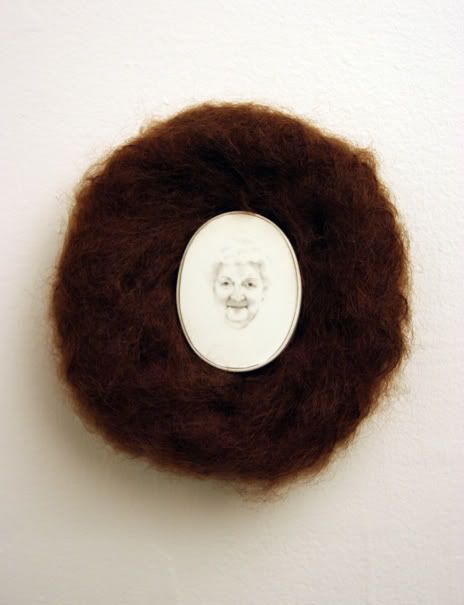
Heir by Langdon Graves
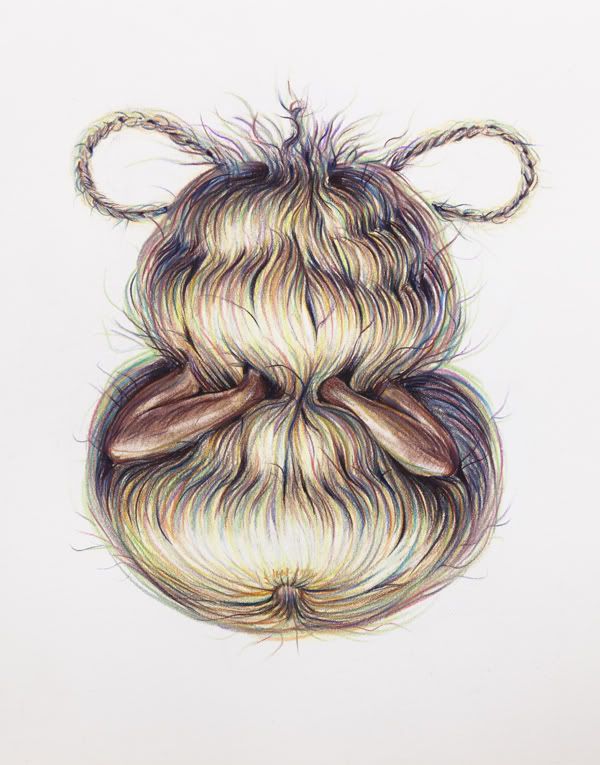
Bear Arms (2011) pencil crayon on paper
14 x 11 in. by Winnie Truong
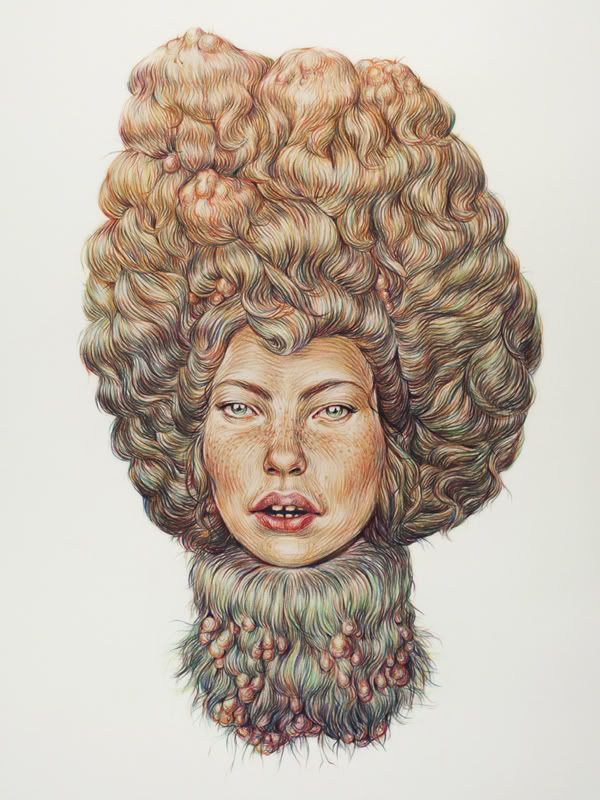
Glamour and Abscess (2010)pencil crayon on paper 36″ x 48″ by Winnie Truong
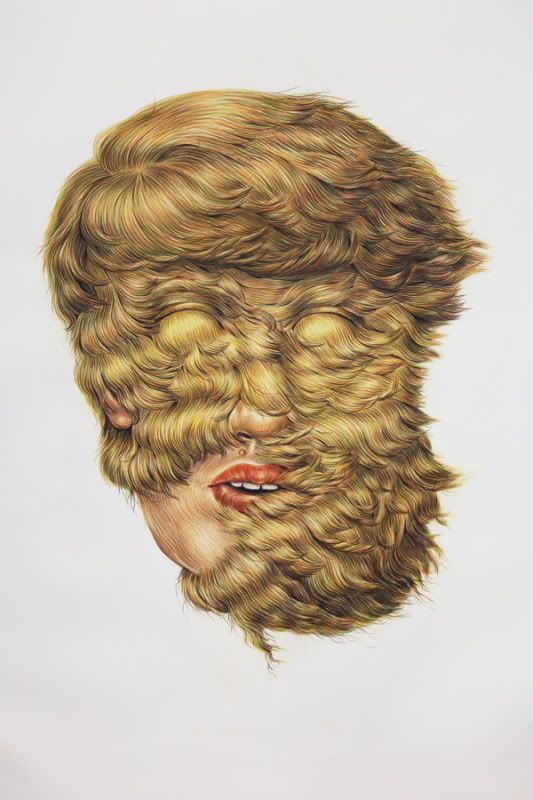
Hard To Win Over (2011)pencil crayon on paper 48″ x 72″ by Winnie Truong
Jeweller Melanie Bilenkar ups the ante by actually using hair as a medium for illustration in her work. (I could do a whole other post on sculpture employing hair as well). She writes, “The Victorians kept lockets of hair and miniature portraits painted with ground hair and pigment to secure the memory of a lost love. In much the same way, I secure my memories through photographic images rendered in lines of my own hair, the physical remnants.”
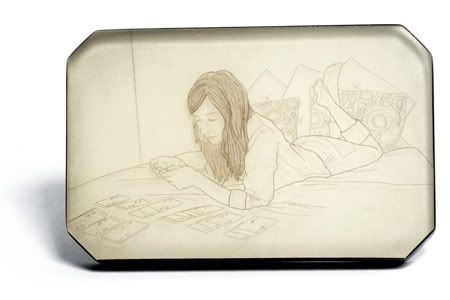
Solitaire, Brooch (2009)
3 1/4”" x 2" x 1/2"
8 x 5.1 x 1.2 cm
Materials: Gold, ebony, resin, pigment, hair
by Melanie Bilenker

all by Melanie Bilenkar (via The Jealous Curator)

Ghost of a Tether, Gala Bent, 2010

The Transmogrification Stunt, Gala Bent, 2009

Unicorn, Gala Bent, 2009

Star Wars, a hair portrait by Mr Bingo

Guns n Roses Hair Portrait by Mr Bingo

The Mighty Boosh Hair Portrait by Mr Bingo

Entire inside, Title of the project: Everything is connected, pencil drawing, size A1 (840mm*600mm) by Eika Dopludo

Into the nature, Title of the project:
Everything is connected, pencil drawing, size A1 (840mm*600mm) by Eika Dopludo

hair meditation © Eika. pencil drawing, size: 200см*150см

Presendential hair portraits by Christina Christoforou (who published a whole book called 'Whose Hair?')

Sister by Langdon Graves

Side by Langdon Graves

Heir by Langdon Graves

Bear Arms (2011) pencil crayon on paper
14 x 11 in. by Winnie Truong

Glamour and Abscess (2010)pencil crayon on paper 36″ x 48″ by Winnie Truong

Hard To Win Over (2011)pencil crayon on paper 48″ x 72″ by Winnie Truong
Jeweller Melanie Bilenkar ups the ante by actually using hair as a medium for illustration in her work. (I could do a whole other post on sculpture employing hair as well). She writes, “The Victorians kept lockets of hair and miniature portraits painted with ground hair and pigment to secure the memory of a lost love. In much the same way, I secure my memories through photographic images rendered in lines of my own hair, the physical remnants.”

Solitaire, Brooch (2009)
3 1/4”" x 2" x 1/2"
8 x 5.1 x 1.2 cm
Materials: Gold, ebony, resin, pigment, hair
by Melanie Bilenker

all by Melanie Bilenkar (via The Jealous Curator)
Monday, August 15, 2011
Wonderwebs
Shane Waltener, who lives and works in London, has an extensive portfolio here. I think cross-breeding lace doilies with cobwebs is more than granny-chic meets natural history; it is genius. He cites both cobwebs and dreamcatchers when describing some of these needlework and crochet fantasies.
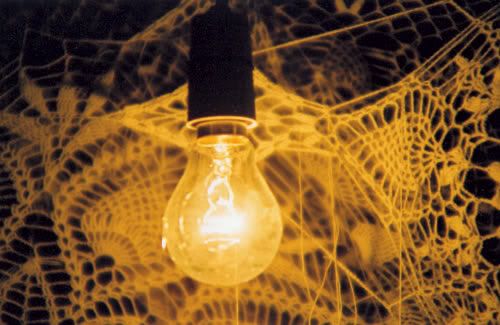
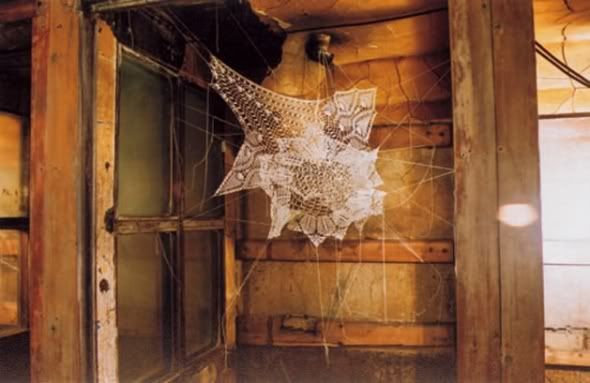
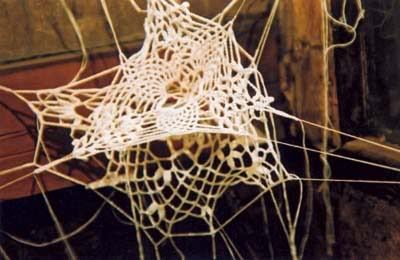
Auntie Peggy Has Departed 2003, mercerised cotton, audio equipment, 2 part looped soundtrack. Aldwych Tube Station, the Strand, London.

Showroom Doily 2004, knicker elastic, 350 x 350 x 300cm. Disused shoe factory, King's Cross, London.
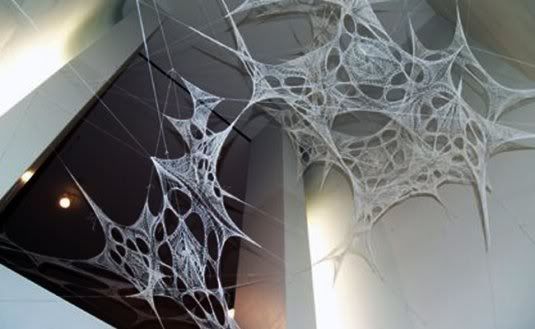
A World Wide Web 2007 - shirring elastic, 25 sq. meters. Museum of Arts and Design, New York.
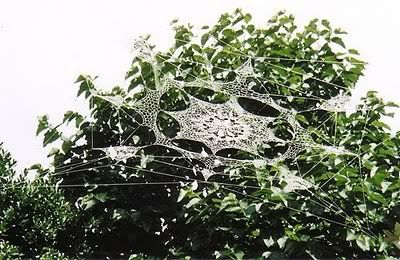
The 26,000 2003, nylon thread, 300 x 300cm. St Mary’s Churchyard, Museum of Garden History, London.
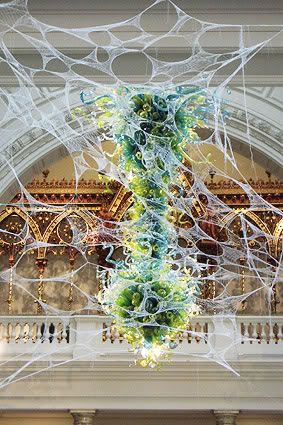
Chihuly Doily 1&2 2004, knicker elastic, each 270 x 350cm. Victoria and Albert Museum, London.
I love that something so beautiful (though perhaps ephemeral) can be created in the medium of "knicker elastic".
(via The Jealous Curator)
The human-working-in-the-spiderweb-medium reminded me of the 'uninvited collaborations' mended spiderwebs of California and Finland based artist Nina Katchadourian. She searched for broken spider webs and repaired the damage as much as posible with (starched or glued) red thread. Day and day, the spiders rejected her repairs, leaving piles of red thread under their own re-repaired webs. She displayed her photographs of the webs with her repairs alongside the later rejected patches.
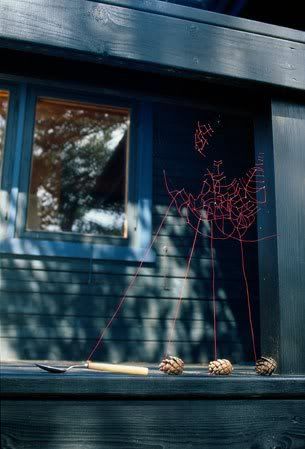
Mended Spiderweb #14 (Spoon Patch)
Cibachrome, 20 x 30 inches, 1998

Mended Spiderweb #8 (Fish Patch)
Cibachrome, 20 x 20 inches, 1998

Marketing Tips for Spiders
Cibachrome, 30 x 20 inches, 1998
See also suspended spiderwebs and feathers, Working with insects (& other animals) and collecting wunderkammer.



Auntie Peggy Has Departed 2003, mercerised cotton, audio equipment, 2 part looped soundtrack. Aldwych Tube Station, the Strand, London.

Showroom Doily 2004, knicker elastic, 350 x 350 x 300cm. Disused shoe factory, King's Cross, London.

A World Wide Web 2007 - shirring elastic, 25 sq. meters. Museum of Arts and Design, New York.

The 26,000 2003, nylon thread, 300 x 300cm. St Mary’s Churchyard, Museum of Garden History, London.

Chihuly Doily 1&2 2004, knicker elastic, each 270 x 350cm. Victoria and Albert Museum, London.
I love that something so beautiful (though perhaps ephemeral) can be created in the medium of "knicker elastic".
(via The Jealous Curator)
The human-working-in-the-spiderweb-medium reminded me of the 'uninvited collaborations' mended spiderwebs of California and Finland based artist Nina Katchadourian. She searched for broken spider webs and repaired the damage as much as posible with (starched or glued) red thread. Day and day, the spiders rejected her repairs, leaving piles of red thread under their own re-repaired webs. She displayed her photographs of the webs with her repairs alongside the later rejected patches.

Mended Spiderweb #14 (Spoon Patch)
Cibachrome, 20 x 30 inches, 1998

Mended Spiderweb #8 (Fish Patch)
Cibachrome, 20 x 20 inches, 1998

Marketing Tips for Spiders
Cibachrome, 30 x 20 inches, 1998
See also suspended spiderwebs and feathers, Working with insects (& other animals) and collecting wunderkammer.
Wednesday, August 10, 2011
Cartographic Music
A three-dimensional city plan as rotating cylindrical pianola drum in Akko Goldenbeld's 'Stadsmuziek' turns map into music. Building height maps unto note intensity with this scale model of Eindhoven, Netherlands, where model buildings strike hammers which hit piano keys. You can 'hear' the urban plan, the density, distribution and size of buildings make unmelodic, but fascinating music.


(via le territoire des sens)
Subscribe to:
Posts (Atom)





